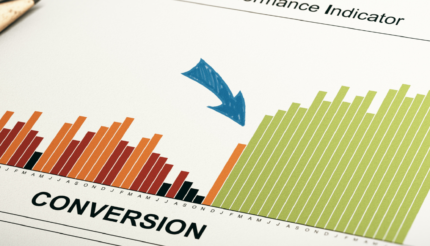You’re obsessed with getting more leads. You spend thousands on marketing agencies, Google ads, and lead generation systems.
You constantly ask: “How do I get more customers?”
But you’re solving the wrong problem entirely.
While you’re pouring money into the most expensive growth tactic available, you’re ignoring four other profit levers that could multiply your results with a fraction of the effort.
The mathematics behind this will shock you.
The Lead Generation Trap
Here’s what’s fundamentally wrong with lead obsession.
Leads are just one input in a five-part profit equation:
Leads × Conversion Rate × Transactions × Average Sale × Margin = Profit
When you only pull the “leads” lever, you miss massive opportunities to grow profit faster and cheaper by improving the others.
Consider the economics. The average cost per lead across industries is £142 for UK B2B companies, with professional services and technology sectors often exceeding £250 per qualified lead.
Meanwhile, improving your conversion rate often requires nothing more than better sales scripts or processes.
Increasing average sale value might just mean bundling products or adjusting pricing structure.
Improving margins could involve operational tweaks or value-based pricing.
These changes cost virtually nothing but return significantly more.
The Mathematics of Compound Growth
Let me show you the mathematical reality most business owners completely miss.
A 10% increase in leads gives you exactly that: 10% more profit.
But a 10% increase across all five profit drivers compounds to a 61% increase in profit.
Here’s the actual calculation using a baseline business example:
Baseline Business:
• 4,000 leads monthly
• 25% conversion rate = 1,000 customers
• 2 transactions per customer annually
• £100 average sale
• 25% margin
• Total annual profit: £50,000
After 10% improvement in each area:
• 4,400 leads
• 27.5% conversion rate = 1,210 customers
• 2.2 transactions per customer
• £110 average sale
• 27.5% margin
• Total annual profit: £80,525
That’s a 61% profit increase from five modest 10% improvements.
This is exponential growth, not linear addition.
Each improvement builds on the next: More leads × better conversion = more customers. More customers × more transactions = more revenue. More revenue × higher margin = exponentially more profit.
Brad Sugars, who developed this business growth formula over 30+ years of coaching thousands of businesses, calls this the compound effect.
The more ambitious your improvements, the more dramatic the compounding effect becomes.
Why You Default to Lead Chasing
If the mathematics are so clear, why do most business owners default to the most expensive, least leveraged tactic?
It’s not because you’re irrational. It’s because of psychological blind spots and practical gaps.
Leads feel tangible and immediate. When a new lead comes in, it feels like progress. It’s visible, trackable, creates a dopamine hit.
You can “see” leads in your CRM. You can’t easily “see” a 10% uptick in conversion efficiency.
It’s what you’ve always been told to do. Marketing culture pushes “top of funnel” obsession: ads, impressions, clicks, traffic.
Agencies sell lead generation because it’s easier to package and measure than operational improvements.
Internal work feels messy and hard. Improving conversion rates requires confronting weak sales processes or team underperformance.
Adjusting margins means making tough pricing decisions.
Increasing transactions means building loyalty programmes and post-sale systems.
These areas feel uncomfortable emotionally and complex operationally.
You’re solving symptoms, not systems. Time-poor owners want quick wins, so they throw money at lead generation because it feels like outsourcing the problem.
Meanwhile, the real profit levers sit untouched.
Statistics support this. Only 22% of businesses are satisfied with their lead conversion rates, indicating massive room for improvement in areas most owners ignore.
The Systematic Implementation Framework
Once you understand the compound effect, the question becomes: where do you start?
Here’s the systematic approach that works:
Step 1: Baseline Your Numbers
Capture your actual metrics across all five areas. Even rough estimates beat guesses.
Most SMEs don’t track conversion rates, transaction frequency, or true margins properly.
What gets measured gets managed. What gets ignored stays broken.
Step 2: Assess Feasibility and Speed
Combine the mathematical potential with real-world filters:
• Where’s the biggest ROI relative to effort?
• What can you win quickly to create belief and cash flow?
• Where’s the bottleneck in your current system?
Step 3: Prioritise the Easiest High-Impact Wins
In most cases, this sequence works best:
Start with conversion rate. This is often horribly under-optimised. Small tweaks like better sales scripts, objection handling, or follow-up processes yield fast gains.
Then tackle average sale value. Easy wins through bundling, upsells, premium positioning, or pricing structure adjustments.
Next, increase transactions per customer. Build post-sale strategies: remarketing, nurture sequences, subscription models.
Address margins carefully. This requires deeper work but delivers powerful results if pricing or cost structures are broken.
Optimise leads last. Only after your machine can convert, upsell, and profit more effectively.
Overcoming the Pricing Fear
Margins represent the most emotionally charged lever in the profit formula.
For many business owners, adjusting pricing feels like touching a live wire.
But this fear is almost always rooted in assumptions, not facts.
Common underlying beliefs include: “My customers will leave,” “I’ll lose to cheaper competitors,” or “We’re already expensive.”
The reality? You’re projecting your own money mindset onto the market.
Use mathematics to reframe the risk. If your margin is 25% and you raise prices by 10%, you can afford to lose nearly 30% of your customers and still make the same profit.
That mathematical reality usually blows minds. Fear gives way to logic.
Reposition price as a value signal. If you’re cheaper than everyone else, are you saying you’re worse?
Higher prices often attract better clients who value service over cost.
Start with low-risk experiments. Test price increases on one product, service, or segment. Introduce premium tiers without touching base prices.
These micro-moves build confidence without betting the farm.
Preventing the Reversion to Old Habits
Getting results is one thing. Sustaining transformation is another.
Once you see some wins, there’s natural temptation to revert to familiar lead-chasing mentality.
Build a monthly rhythm around the five levers. Create a dashboard tracking all five metrics monthly.
If it’s visible, it stays real. This shifts your mindset from activity to leverage.
Reinforce identity, not just tactics. You’re no longer a business owner who chases leads. You’re a profit strategist who pulls the right lever at the right time.
Use wins to anchor belief. When you get a 10% conversion improvement from a new script, don’t just celebrate the result. Unpack the cause.
“See what happened when we improved conversion instead of chasing more leads? That’s leverage.”
Create a lead generation quarantine rule. For 90 days, you’re not allowed to spend more on lead generation until you lift at least two other levers.
This forces discipline and focuses creativity where it matters most.
Lock in strategic review time. Monthly CEO strategy sessions where you work on the business, not in it.
Review the dashboard. Choose one lever to improve. Define the test or change. Capture the insight.
You’re building a habit loop: Data → Insight → Action → Result → Repeat.
The Transformation Mindset
What separates businesses that truly transform from those that revert to old patterns?
The owner’s willingness to shift from operator to architect.
Businesses that master this integrated approach are led by people who detach their ego from doing and focus on designing systems that do.
They move from “How do I fix this?” to “How do I make sure this never breaks again?”
They ask better questions: “What’s the lever?” instead of “What’s the fire?”
The ones who revert never let go of the old identity. They still feel most valuable when fixing, pushing, hustling.
They confuse busyness with effectiveness.
Even when they see results, they subconsciously sabotage by reintroducing chaos because chaos feels familiar.
True transformation looks different. The business runs on rhythm without constant heroic effort.
Decisions get made through a leverage lens: “Which lever moves profit fastest?”
The team speaks the same language: leads, conversions, margins.
The owner becomes calm, not frantic, because they understand how the engine works and which levers move which results.
They’ve shifted from being the engine to being the engineer.
Your Next Action
Stop asking “How do I get more leads?”
Start asking “Where’s the easiest place to increase profit in my business?”
Often, it’s not at the top of your funnel. It’s in tightening up everything after that.
Baseline your five metrics this week. Run the compound calculation on your own numbers.
You’ll be shocked at what you discover.
The mathematics don’t lie. Small improvements across interconnected systems create exponential results.
That’s not theory. That’s the compound effect in action.





